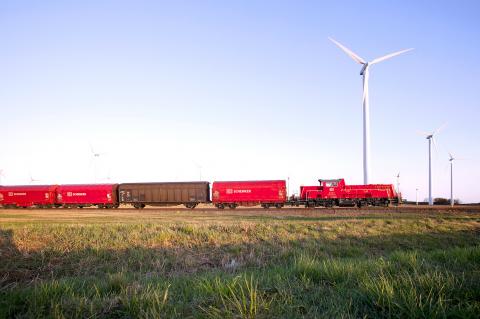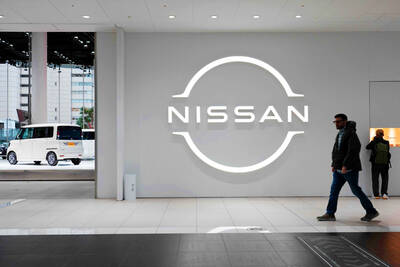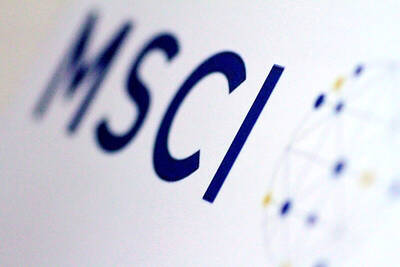It will not be easy to run a national railway on renewable energy like wind, hydro and solar power, but that is what Germany’s Deutsche Bahn aims to do for one simple reason: It is what consumers want.
Deutsche Bahn says it wants to raise the percentage of wind, hydro and solar energy to power its trains from 20 percent now to 28 percent in 2014 and become carbon-free by 2050.
“Consumers in Germany have made it clear they want us all to get away from nuclear energy and to more renewable energy,” Deutsche Bahn Energie chief executive Hans-Juergen Witschke said of the railway’s attention-grabbing revised targets that exceed the government’s already ambitious national aims.

Photo: Reuters
“It’s what customers want and we’re making it happen,” Witschke said in an interview.
Prevailing attitudes in Germany were already decidedly green before the nuclear accident Japan’s Fukushima Dai-ichi nuclear power plant in March prompted a head-first dive into renewables.
The Berlin government abruptly reversed course on nuclear power, shutting eight nuclear plants and vowing to close the other nine by 2022.
That caught Deutsche Bahn — and German industry — off guard. The state-owned railways had relied heavily on nuclear energy. However, now the public and industry are increasingly attuned to sustainability and what companies are doing, Witschke said.
Some transport industry analysts are skeptical.
“It sounds like a bit of ‘green-washing,’” said Stefan Kick, an analyst at Silvia Quandt Research, a Frankfurt brokerage. “Obviously costs for renewable energy are going to be higher. Yet if customers are truly willing to pay, it could make sense.”
The railway’s new push for a larger share of renewable energy to operate trains that transport 1.9 billion passengers and 415 million tonnes of freight each year has won applause from environmental groups.
They have cheered Deutsche Bahn’s partnerships with wind and hydroelectric power suppliers and its exploratory moves into harvesting solar power from the roofs of its 5,700 stations.
Previously, environmentalists had accused the firm of neglecting to develop renewables on its vast properties and because of its heavy reliance on nuclear power.
Peter Ahmels, a renewable energy specialist at the German Environmental Aid Association (DUH), said the railways could have done more with wind and solar on its property holdings.
Instead, he said Deutsche Bahn had relied complacently on its image as a low-emission mode of transport.
It could do this because even high speed trains have carbon dioxide emissions per passenger per kilometer of 46g, compared with an average 140g for cars and 180g for planes.
“Since Fukushima, Deutsche Bahn has been moving in the right direction,” Ahmels said. “There’s clearly a new thinking on the board. They’re doing sensible things. Before they resisted. The argument was that renewables were not their core business.”
Deutsche Bahn also operates myriad local rail operations in towns and cities. Some operations, such as local railways in Hamburg and Saarland, already run on 100 percent renewable energy and proudly boast about that in advertising.
To run its trains the railways use a staggering amount of electricity every year: 12 terawatt hours. That is as much as Berlin with its 3.2 million residents consumes.
The railways alone use 2 percent of Germany’s total electricity. A single high-speed ICE train traveling from Frankfurt to Berlin uses 4,800kwh, enough for a four-person family for a full year.
Germany is already a world leader in renewable energy. About 17 percent comes from renewables, up from 6 percent in 2000.
The German government aims to raise that share to 35 percent by 2020 and 80 percent by 2050. Witschke said Deutsche Bahn will have 35 or 40 percent by 2020 and 100 percent by the middle of the century.
Some passengers and business partners, such as carmaker Audi, already voluntarily pay small surcharges for carbon dioxide-free transport packages that guarantee green power is used.
To help meet their targets, Deutsche Bahn has been operating two wind farms in Brandenburg and last month signed a 1.3 billion euro (US$1.88 billion) deal with utility RWE to get 900 million kwh a year from 14 hydroelectric plants — enough for 250,000 households.
Because there are still questions about the reliability of renewable energy until the storage capacities can be increased, Witschke said he carefully tracks the wind parks to learn more.
The hydroelectric deal with RWE runs for 15 years and will supply the railways with about 8 percent of its needs.
“It does have quite a symbolic impact when the country’s largest electricity user takes such a big step into regenerative energy,” Witschke said. “We’re also one of the biggest electricity users anywhere in Europe. It’s not going unnoticed.”

PERSISTENT RUMORS: Nvidia’s CEO said the firm is not in talks to sell AI chips to China, but he would welcome a change in US policy barring the activity Nvidia Corp CEO Jensen Huang (黃仁勳) said his company is not in discussions to sell its Blackwell artificial intelligence (AI) chips to Chinese firms, waving off speculation it is trying to engineer a return to the world’s largest semiconductor market. Huang, who arrived in Taiwan yesterday ahead of meetings with longtime partner Taiwan Semiconductor Manufacturing Co (TSMC, 台積電), took the opportunity to clarify recent comments about the US-China AI race. The Nvidia head caused a stir in an interview this week with the Financial Times, in which he was quoted as saying “China will win” the AI race. Huang yesterday said

Nissan Motor Co has agreed to sell its global headquarters in Yokohama for ¥97 billion (US$630 million) to a group sponsored by Taiwanese autoparts maker Minth Group (敏實集團), as the struggling automaker seeks to shore up its financial position. The acquisition is led by a special purchase company managed by KJR Management Ltd, a Japanese real-estate unit of private equity giant KKR & Co, people familiar with the matter said. KJR said it would act as asset manager together with Mizuho Real Estate Management Co. Nissan is undergoing a broad cost-cutting campaign by eliminating jobs and shuttering plants as it grapples

The Chinese government has issued guidance requiring new data center projects that have received any state funds to only use domestically made artificial intelligence (AI) chips, two sources familiar with the matter told Reuters. In recent weeks, Chinese regulatory authorities have ordered such data centers that are less than 30 percent complete to remove all installed foreign chips, or cancel plans to purchase them, while projects in a more advanced stage would be decided on a case-by-case basis, the sources said. The move could represent one of China’s most aggressive steps yet to eliminate foreign technology from its critical infrastructure amid a

MORE WEIGHT: The national weighting was raised in one index while holding steady in two others, while several companies rose or fell in prominence MSCI Inc, a global index provider, has raised Taiwan’s weighting in one of its major indices and left the country’s weighting unchanged in two other indices after a regular index review. In a statement released on Thursday, MSCI said it has upgraded Taiwan’s weighting in the MSCI All-Country World Index by 0.02 percentage points to 2.25 percent, while maintaining the weighting in the MSCI Emerging Markets Index, the most closely watched by foreign institutional investors, at 20.46 percent. Additionally, the index provider has left Taiwan’s weighting in the MSCI All-Country Asia ex-Japan Index unchanged at 23.15 percent. The latest index adjustments are to